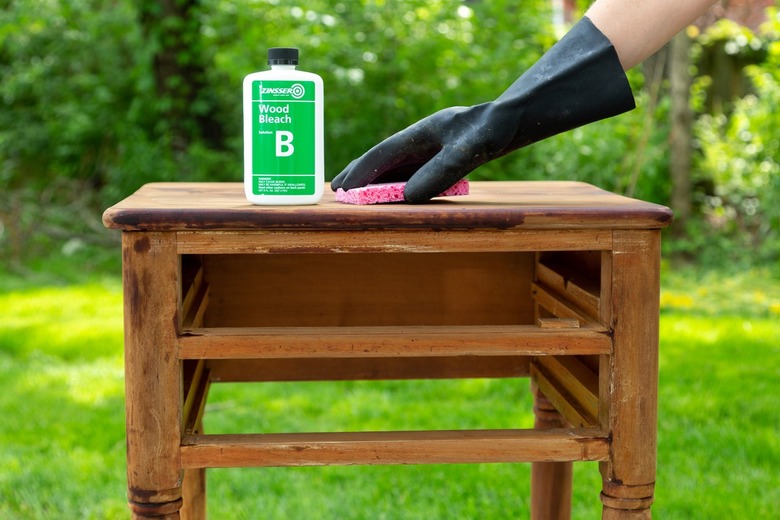How To Repair A Burn Mark On Wood Furniture
We may receive a commission on purchases made from links.
Discovering a burn mark on a wood table or other piece of furniture isn't necessarily a disaster. A scorch mark from cigarette ash or a hot pan may only need buffing, while a larger burn may need scraping and filling before touching up the finish. Once you have removed and repaired the burnt area, restore the finish so no one will ever know that your furniture was damaged.
Remove a Scorch Mark
Remove a Scorch Mark
A scorch mark that didn't result in charred wood causes varying levels of damage to the surface. A very light mark may be resolved by applying a glob of mayonnaise over the brown mark and leaving it for several hours or overnight. The oils and moisture help rehydrate the underlying wood, and once buffed off, it may be all that you need to do to repair the wood surface. Always test it on an inconspicuous spot first to make sure it won't further damage the finish and wood.
A light scrub of 1 teaspoon baking soda and 1/8 teaspoon water mixed to make a paste can be used to remove light-colored scorch marks from dark wood. Use a clean rag to apply a dab of the paste on the mark and rub gently with the grain of the wood until it darkens to match the original dark tones. Wipe it clean and allow it to dry.
A deeper and darker scorch mark may be removed by lightly rubbing the damaged area with superfine #0000 steel wool moistened with mineral oil. Rub the area with the grain of the wood until the mark disappears. If it is still stained, try dipping a cotton swab in chlorine bleach and applying a small amount to the brown area. Let it soak in and bleach the stain before removing it with fresh water and a sponge. Dry it immediately with a clean rag.
Repair a Burn Mark on a Wood Table
Repair a Burn Mark on a Wood Table
Blackened and charred wood requires a more robust approach. Put on your work gloves and safety goggles before carefully scraping the charred area with a sharp knife or the razor-sharp curved blade of a craft knife. You will probably have to scrape down to bare wood but avoid removing more than the burnt area.
Dip a cotton swab into naphtha and clean the wood. Use caution when working with naphtha, as it is highly flammable. Use superfine steel wool or a fine-grit sandpaper and sand with the grain to smooth the surface. Fill holes or dents with a matching or stainable wood filler, smooth them, and allow them to dry completely.
Determine the Finish
Determine the Finish
While lightly scorched finishes can usually be restored by simply applying your regular furniture polish and buffing, deeper damage needs additional work to complete the repair. Before you restore the wood surface, you need to know what kind of finish was used when the furniture was made. An older piece may have a finish of shellac or lacquer or a water-based finish. Newer furniture may be coated with varnish or polyurethane.
To determine the finish type, begin with a drop or two of denatured alcohol on an inconspicuous location and let it sit for a few seconds. Then use a brush or rag to touch the spot. If it has softened and become a little sticky, the finish is shellac.
If nothing happens, try a drop of lacquer thinner on a new spot. If the finish softens, it's lacquer, but if it only gets tacky, try xylene to see if it gets gummy, which indicates a water-based finish. If none of the solvent tests soften the finish, the furniture was finished with varnish or polyurethane.
Restore the Finish
Restore the Finish
Repaired areas may require a touch-up with matching wood stain. After lightly sanding the repaired area so it is smooth and after removing dust with a tack cloth, apply light layers of stain according to the manufacturer's directions until it matches the surrounding finish. A combined stain and polyurethane product may need light scuffing between coats with a fine-grit sandpaper or a gray scrubby if you're applying a water-based finish or superfine steel wool for an oil-based product.
You can restore a shellac or lacquer finish with denatured alcohol or lacquer thinner, respectively, by dissolving and flowing the original finish to cover the area. Add a little more of the same product if necessary to completely cover the repairs without affecting the surrounding finish.
After the finish completely dries, wax and buff the furniture to blend the old and new. To prevent further damage, keep hot pads or trivets handy for hot pans or casserole dishes. Avoid cigarette burns by putting ashtrays wherever smokers sit or simply forbid smoking inside your home.
